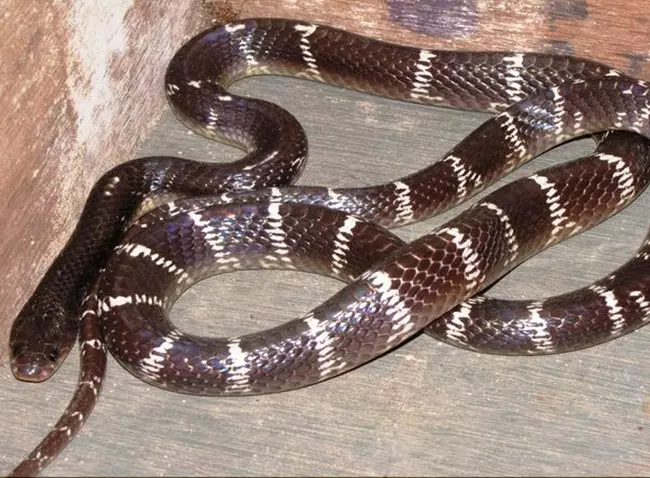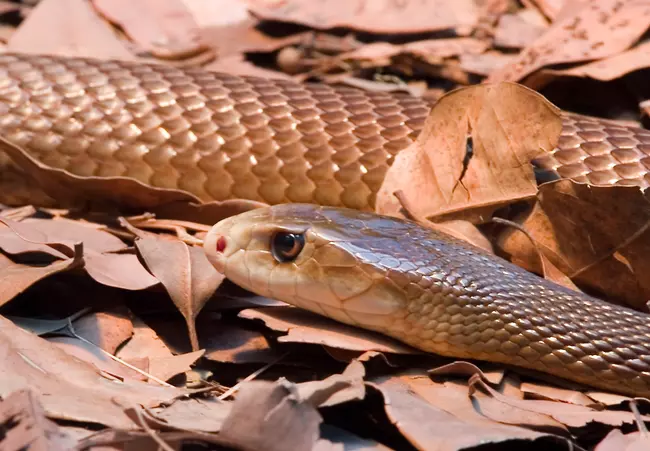Three of the presumably the most poisonous snake species on Earth
There are about 2,500 species of snakes in the world, of which more than 600 species are poisonous. But which snakes have the deadliest venom by far on Earth?
The Common krait (Bungarus caeruleus)
Common krait (Bungarus caeruleus); Source: By Jayendra Chiplunkar - Own work, CC BY-SA 3.0, https://commons.wikimedia.org/w/index.php?curid=17650765
One of the most dangerous venomous snake species in the world, native to tropical Asia like the jungles of India, Indonesia, Shri Lanka, Borneo. Its average length is 0.9 meters, but specimens as large as 1.75 meters have also been found. It has small eyes and round pupils. The base color of the snake is usually black or bluish-black with white cross stripes, the upper lips and the belly are white.
It feeds on other snakes, lizards and rodents, and even cannibalism can be observed in them. Its venom consists mostly of neurotoxins, causing muscle paralysis. These snakes are nocturnal, during the rainy season, they seek out dry places like inside a house. Bite often feels like that of an ant or mosquito so the victim may die without even waking up.
If death occurs(untreated mortality rate of 70-80%), it takes place about four to eight hours after the krait bite. The cause of death is a general respiratory failure.
Tiger snake (Notechis scutatus)
Tiger snake (Notechis scutatus); Source: flickr.com / Catching The Eye, License: CC BY 2.0, License link: https://creativecommons.org/licenses/by/2.0/; Link: https://www.flickr.com/photos/160417453@N04/27079559468
Native to southern Australia and the island of Tasmania. The diversity in color makes it difficult to recognize. They are usually banded similar to the pattern of a tiger, their appearance varies depending on the region. Individuals also show seasonal variation in color. Its specimens have a length of 1.2 meters. They usually mate in spring when it is in the warmer seasons and will give birth to 20-30 live young ones. The tiger snake inhabits coastal environments, wetlands, waterfront environments, where it usually hunts small mammals and smaller reptiles.
The venom consists of potent neurotoxins, coagulants, hemolysins(lipids and proteins that cause the breakdown of red blood cells), and myotoxins( a non-enzymatic mechanism that leads to severe muscle necrosis). Symptoms of a bite include localized pain in the foot and neck region, tingling, numbness, and sweating, followed by a fairly rapid onset of breathing difficulties and paralysis.
The mortality rate from untreated bites is reported to be between 40% and 60%.
The Inland taipan (Oxyuranus microlepidotus)
Inland taipan (Oxyuranus microlepidotus); Source: flickr.com / John, License: CC BY-SA 2.0; License link: https://creativecommons.org/licenses/by-sa/2.0/; Link: https://www.flickr.com/photos/shebalso/111863661
The world's most dangerous venomous snake, is native to the arid, interior of Australia. Its venom is 200-400x stronger than most rattlesnake species, and the venom of cobras is 50x! The venom of the snake is neurotoxic, meaning it attacks the nervous system and is thus able to cause the death of an adult within 30 to 45 minutes if untreated. It is estimated that one bite possesses enough lethality to kill at least 100 fully grown men. Depending on the season, the animal can vary in color from dark brown to light olive green, and its individuals averages approximately 1.8 meters in length. It feeds mainly on rodents.
It is known to deliver up to eight venomous bites in a single attack. Lives in dug cavities and rock cracks. Produces clutches of between one dozen and two dozen eggs. The eggs hatch two months later.
Many reptile keepers consider it a calm snake. Inland taipans are seldom encountered in the wild because as a result of their remoteness and brief above-ground appearance during the day. However, a safe distance should be maintained if provoked, mishandled, or prevented from escaping it will defend itself and can inflict a potentially fatal bite.
May 2020


